check engine light TOYOTA YARIS 2022 Owners Manual
[x] Cancel search | Manufacturer: TOYOTA, Model Year: 2022, Model line: YARIS, Model: TOYOTA YARIS 2022Pages: 590, PDF Size: 128.6 MB
Page 6 of 590
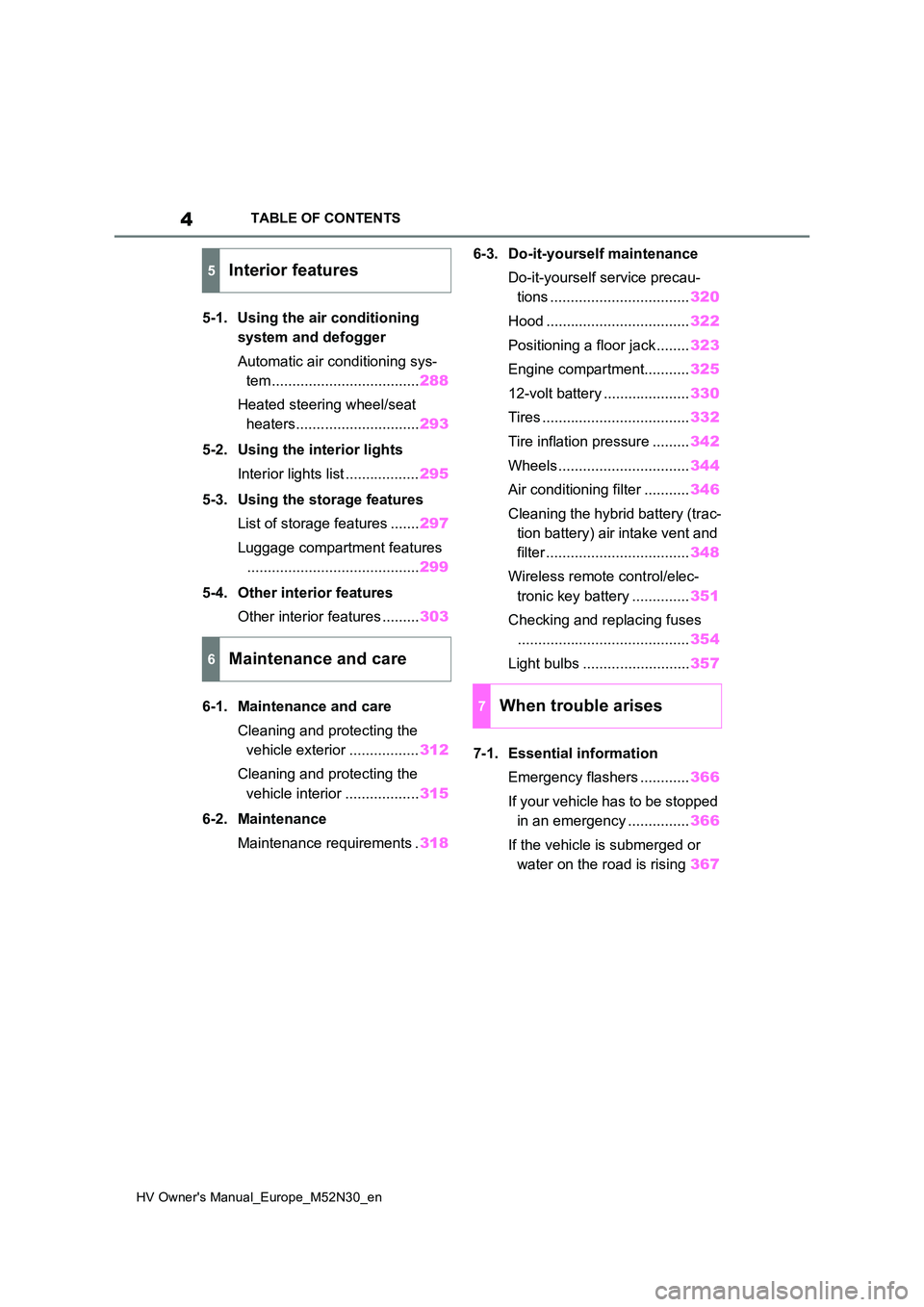
4
HV Owner's Manual_Europe_M52N30_en
TABLE OF CONTENTS
5-1. Using the air conditioning
system and defogger
Automatic air conditioning sys-
tem .................................... 288
Heated steering wheel/seat
heaters.............................. 293
5-2. Using the interior lights
Interior lights list .................. 295
5-3. Using the storage features
List of storage features ....... 297
Luggage compartment features
.......................................... 299
5-4. Other interior features
Other interior features ......... 303
6-1. Maintenance and care
Cleaning and protecting the
vehicle exterior ................. 312
Cleaning and protecting the
vehicle interior .................. 315
6-2. Maintenance
Maintenance requirements . 318
6-3. Do-it-yourself maintenance
Do-it-yourself service precau-
tions .................................. 320
Hood ................................... 322
Positioning a floor jack ........ 323
Engine compartment........... 325
12-volt battery ..................... 330
Tires .................................... 332
Tire inflation pressure ......... 342
Wheels ................................ 344
Air conditioning filter ........... 346
Cleaning the hybrid battery (trac-
tion battery) air intake vent and
filter ................................... 348
Wireless remote control/elec-
tronic key battery .............. 351
Checking and replacing fuses
.......................................... 354
Light bulbs .......................... 357
7-1. Essential information
Emergency flashers ............ 366
If your vehicle has to be stopped
in an emergency ............... 366
If the vehicle is submerged or
water on the road is rising 367
5Interior features
6Maintenance and care
7When trouble arises
Page 15 of 590
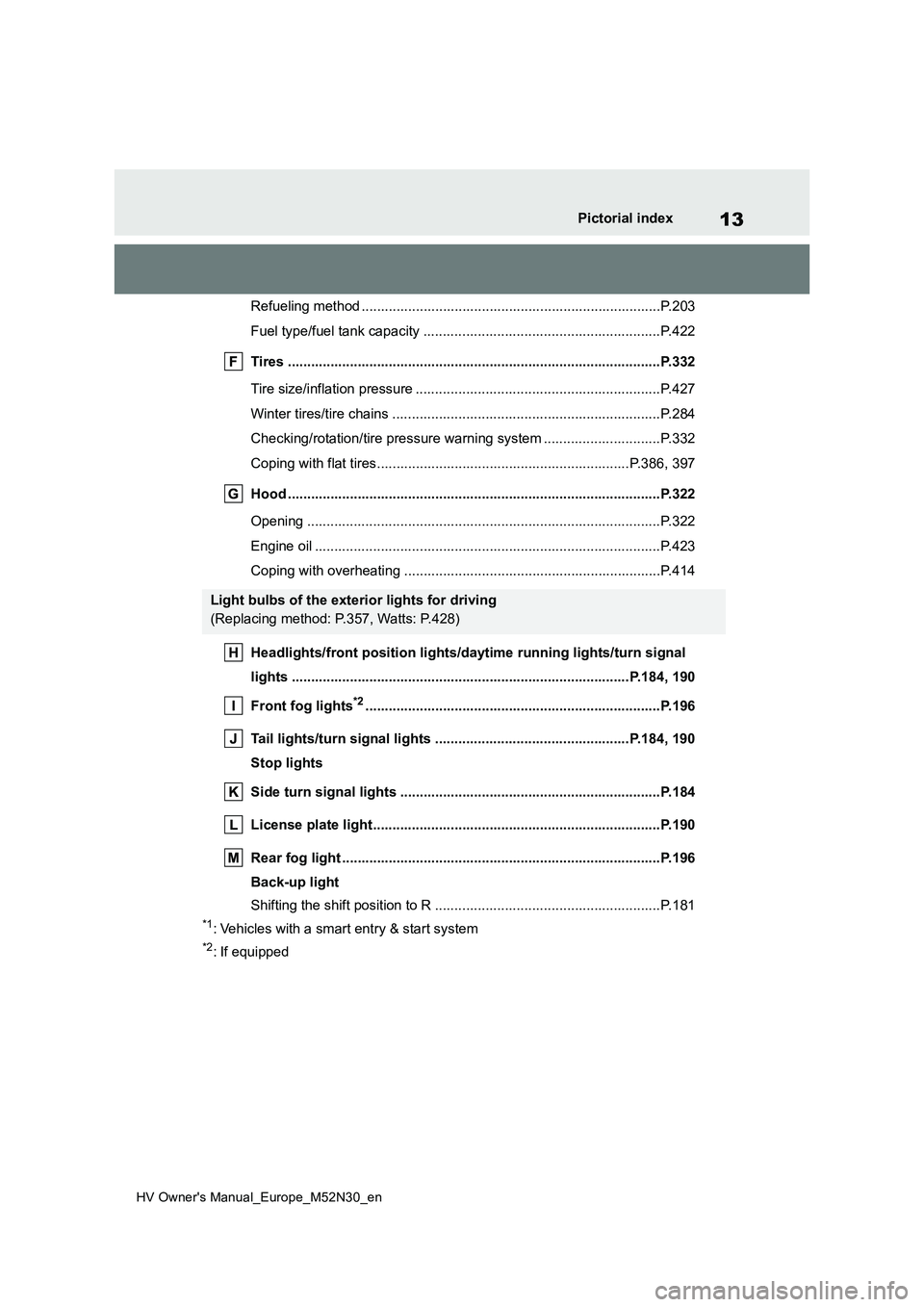
13
HV Owner's Manual_Europe_M52N30_en
Pictorial index
Refueling method .............................................................................P.203
Fuel type/fuel tank capacity ................................... ..........................P.422
Tires .......................................................... ......................................P.332
Tire size/inflation pressure ................................... ............................P.427
Winter tires/tire chains ....................................... ..............................P.284
Checking/rotation/tire pressure warning system ................. .............P.332
Coping with flat tires......................................... ........................P.386, 397
Hood ........................................................... .....................................P.322
Opening ........................................................ ...................................P.322
Engine oil ..................................................... ....................................P.423
Coping with overheating ........................................ ..........................P.414
Headlights/front position lights/daytime running lights/turn si gnal
lights ......................................................... ..............................P.184, 190
Front fog lights*2............................................................... .............P.196
Tail lights/turn signal lights ................................. .................P.184, 190
Stop lights
Side turn signal lights ........................................ ...........................P.184
License plate light............................................ ..............................P.190
Rear fog light ................................................. .................................P.196
Back-up light
Shifting the shift position to R ............................... ...........................P.181
*1: Vehicles with a smart entry & start system
*2: If equipped
Light bulbs of the exterior lights for driving
(Replacing method: P.357, Watts: P.428)
Page 164 of 590
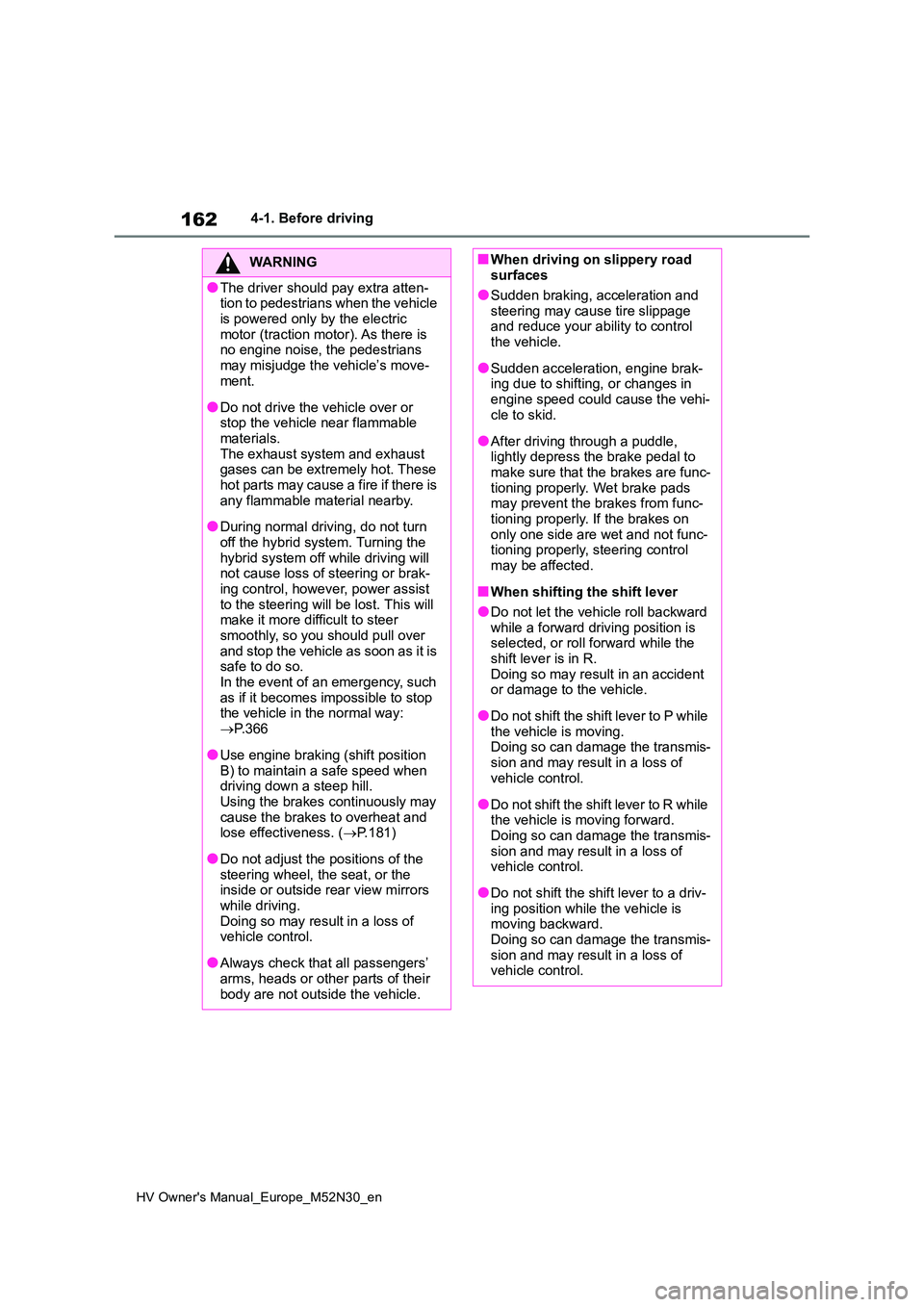
162
HV Owner's Manual_Europe_M52N30_en
4-1. Before driving
WARNING
●The driver should pay extra atten- tion to pedestrians when the vehicle
is powered only by the electric motor (traction motor). As there is no engine noise, the pedestrians
may misjudge the vehicle’s move- ment.
●Do not drive the vehicle over or stop the vehicle near flammable materials.
The exhaust system and exhaust gases can be extremely hot. These hot parts may cause a fire if there is
any flammable material nearby.
●During normal driving, do not turn
off the hybrid system. Turning the hybrid system off while driving will not cause loss of steering or brak-
ing control, however, power assist to the steering will be lost. This will make it more difficult to steer
smoothly, so you should pull over and stop the vehicle as soon as it is safe to do so.
In the event of an emergency, such as if it becomes impossible to stop the vehicle in the normal way:
P. 3 6 6
●Use engine braking (shift position
B) to maintain a safe speed when driving down a steep hill.Using the brakes continuously may
cause the brakes to overheat and lose effectiveness. ( P.181)
●Do not adjust the positions of the steering wheel, the seat, or the inside or outside rear view mirrors
while driving. Doing so may result in a loss of vehicle control.
●Always check that all passengers’ arms, heads or other parts of their
body are not outside the vehicle.
■When driving on slippery road surfaces
●Sudden braking, acceleration and
steering may cause tire slippage and reduce your ability to control the vehicle.
●Sudden acceleration, engine brak-ing due to shifting, or changes in
engine speed could cause the vehi- cle to skid.
●After driving through a puddle, lightly depress the brake pedal to make sure that the brakes are func-
tioning properly. Wet brake pads may prevent the brakes from func-tioning properly. If the brakes on
only one side are wet and not func- tioning properly, steering control may be affected.
■When shifting the shift lever
●Do not let the vehicle roll backward
while a forward driving position is selected, or roll forward while the shift lever is in R.
Doing so may result in an accident or damage to the vehicle.
●Do not shift the shift lever to P while the vehicle is moving.Doing so can damage the transmis-
sion and may result in a loss of vehicle control.
●Do not shift the shift lever to R while the vehicle is moving forward.Doing so can damage the transmis-
sion and may result in a loss of vehicle control.
●Do not shift the shift lever to a driv-ing position while the vehicle is moving backward.
Doing so can damage the transmis- sion and may result in a loss of vehicle control.
Page 165 of 590
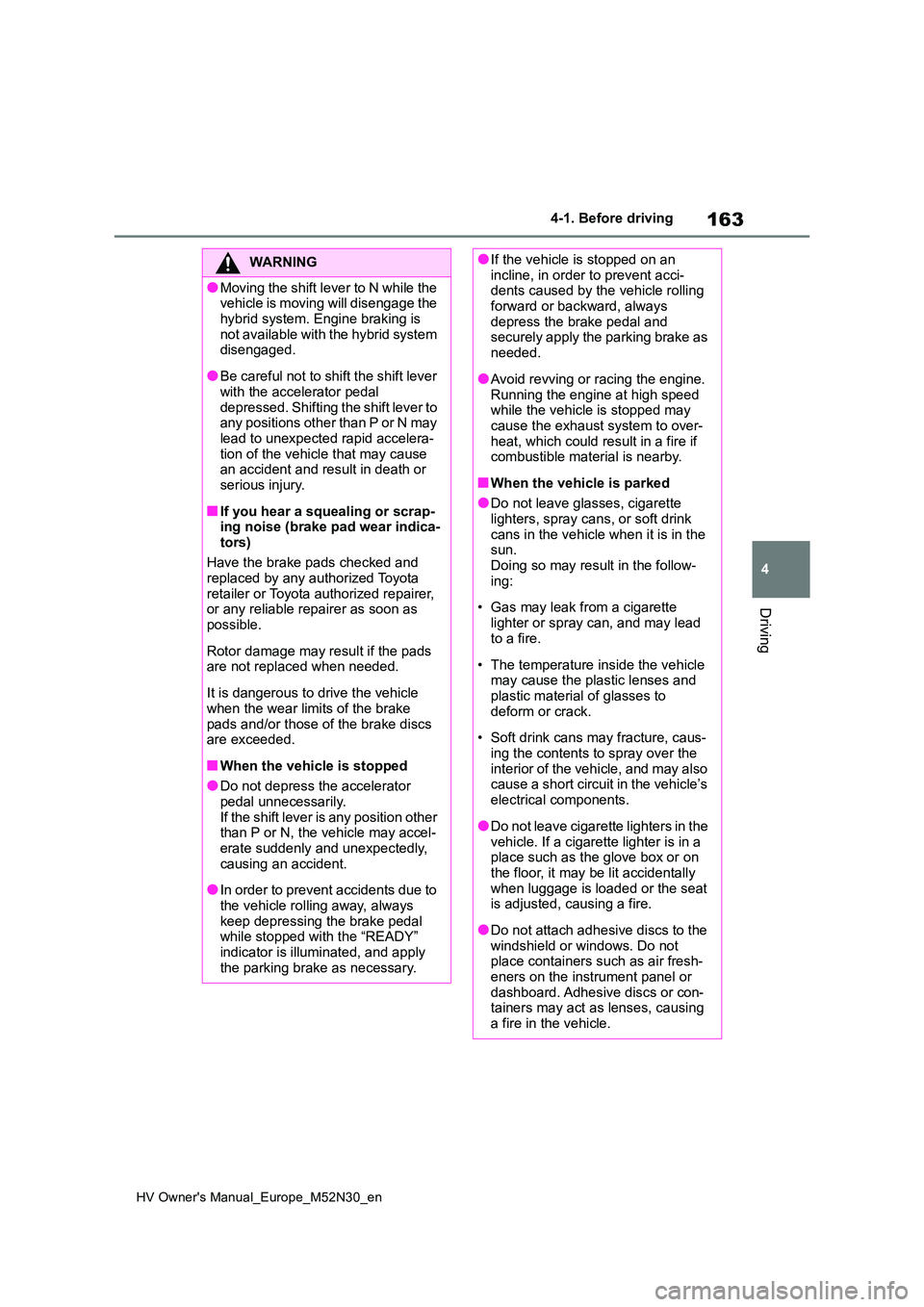
163
4
HV Owner's Manual_Europe_M52N30_en
4-1. Before driving
Driving
WARNING
●Moving the shift lever to N while the vehicle is moving will disengage the
hybrid system. Engine braking is not available with the hybrid system disengaged.
●Be careful not to shift the shift lever with the accelerator pedal
depressed. Shifting the shift lever to any positions other than P or N may lead to unexpected rapid accelera-
tion of the vehicle that may cause an accident and result in death or serious injury.
■If you hear a squealing or scrap-ing noise (brake pad wear indica-
tors)
Have the brake pads checked and replaced by any authorized Toyota
retailer or Toyota authorized repairer, or any reliable repairer as soon as possible.
Rotor damage may result if the pads are not replaced when needed.
It is dangerous to drive the vehicle when the wear limits of the brake
pads and/or those of the brake discs are exceeded.
■When the vehicle is stopped
●Do not depress the accelerator pedal unnecessarily.
If the shift lever is any position other than P or N, the vehicle may accel-erate suddenly and unexpectedly,
causing an accident.
●In order to prevent accidents due to
the vehicle rolling away, always keep depressing the brake pedal while stopped with the “READY”
indicator is illuminated, and apply the parking brake as necessary.
●If the vehicle is stopped on an incline, in order to prevent acci-dents caused by the vehicle rolling
forward or backward, always depress the brake pedal and securely apply the parking brake as
needed.
●Avoid revving or racing the engine.
Running the engine at high speed while the vehicle is stopped may cause the exhaust system to over-
heat, which could result in a fire if combustible material is nearby.
■When the vehicle is parked
●Do not leave glasses, cigarette lighters, spray cans, or soft drink
cans in the vehicle when it is in the sun.Doing so may result in the follow-
ing:
• Gas may leak from a cigarette
lighter or spray can, and may lead to a fire.
• The temperature inside the vehicle may cause the plastic lenses and plastic material of glasses to
deform or crack.
• Soft drink cans may fracture, caus-
ing the contents to spray over the interior of the vehicle, and may also cause a short circuit in the vehicle’s
electrical components.
●Do not leave cigarette lighters in the
vehicle. If a cigarette lighter is in a place such as the glove box or on the floor, it may be lit accidentally
when luggage is loaded or the seat is adjusted, causing a fire.
●Do not attach adhesive discs to the windshield or windows. Do not place containers such as air fresh-
eners on the instrument panel or dashboard. Adhesive discs or con-tainers may act as lenses, causing
a fire in the vehicle.
Page 284 of 590
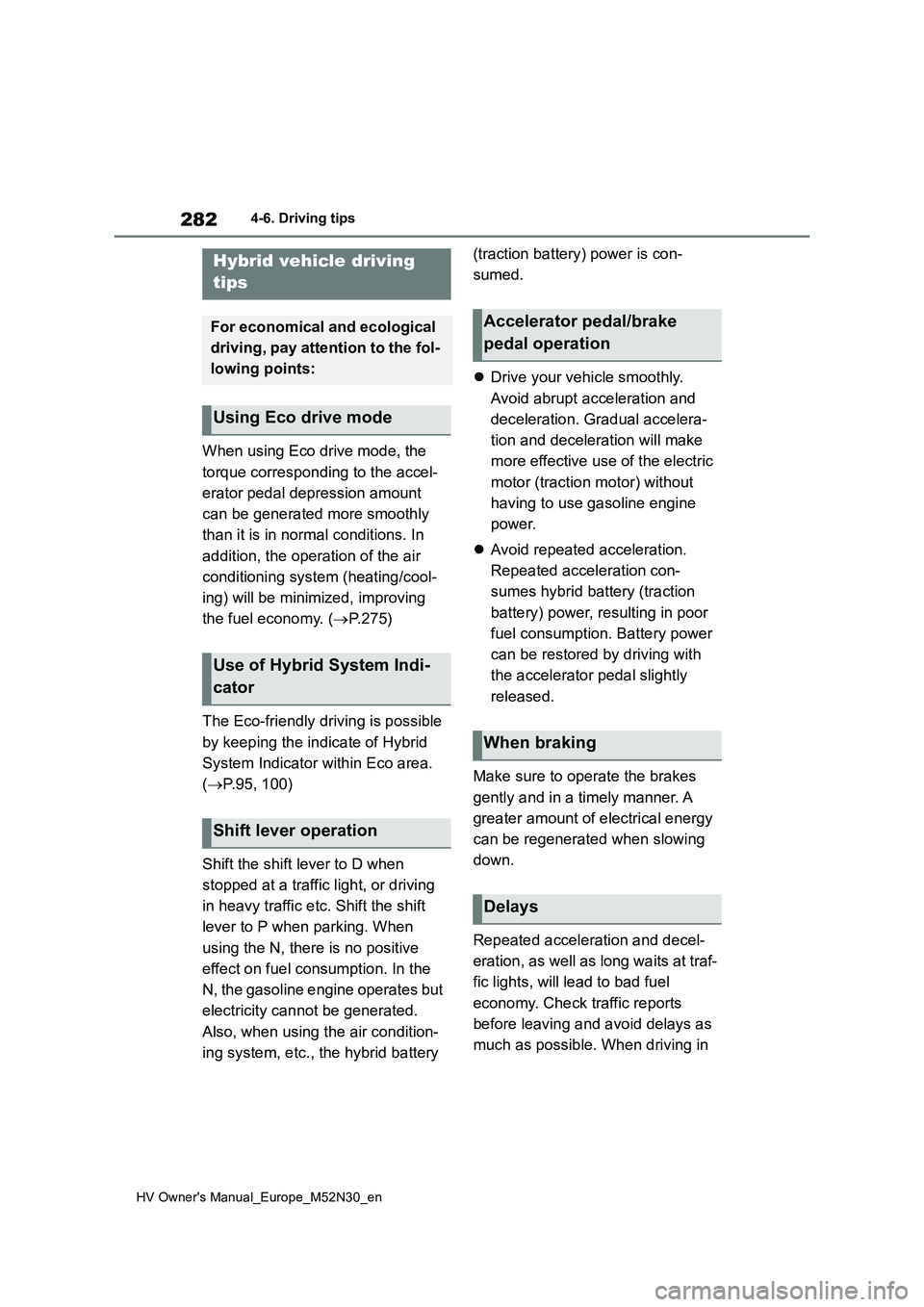
282
HV Owner's Manual_Europe_M52N30_en
4-6. Driving tips
4-6.Driving tips
When using Eco drive mode, the
torque corresponding to the accel-
erator pedal depression amount
can be generated more smoothly
than it is in normal conditions. In
addition, the operation of the air
conditioning system (heating/cool-
ing) will be minimized, improving
the fuel economy. ( P. 2 7 5 )
The Eco-friendly driving is possible
by keeping the indicate of Hybrid
System Indicator within Eco area.
( P.95, 100)
Shift the shift lever to D when
stopped at a traffic light, or driving
in heavy traffic etc. Shift the shift
lever to P when parking. When
using the N, there is no positive
effect on fuel consumption. In the
N, the gasoline engine operates but
electricity cannot be generated.
Also, when using the air condition-
ing system, etc., the hybrid battery
(traction battery) power is con-
sumed.
Drive your vehicle smoothly.
Avoid abrupt acceleration and
deceleration. Gradual accelera-
tion and deceleration will make
more effective use of the electric
motor (traction motor) without
having to use gasoline engine
power.
Avoid repeated acceleration.
Repeated acceleration con-
sumes hybrid battery (traction
battery) power, resulting in poor
fuel consumption. Battery power
can be restored by driving with
the accelerator pedal slightly
released.
Make sure to operate the brakes
gently and in a timely manner. A
greater amount of electrical energy
can be regenerated when slowing
down.
Repeated acceleration and decel-
eration, as well as long waits at traf-
fic lights, will lead to bad fuel
economy. Check traffic reports
before leaving and avoid delays as
much as possible. When driving in
Hybrid vehicle driving
tips
For economical and ecological
driving, pay attention to the fol-
lowing points:
Using Eco drive mode
Use of Hybrid System Indi-
cator
Shift lever operation
Accelerator pedal/brake
pedal operation
When braking
Delays
Page 285 of 590
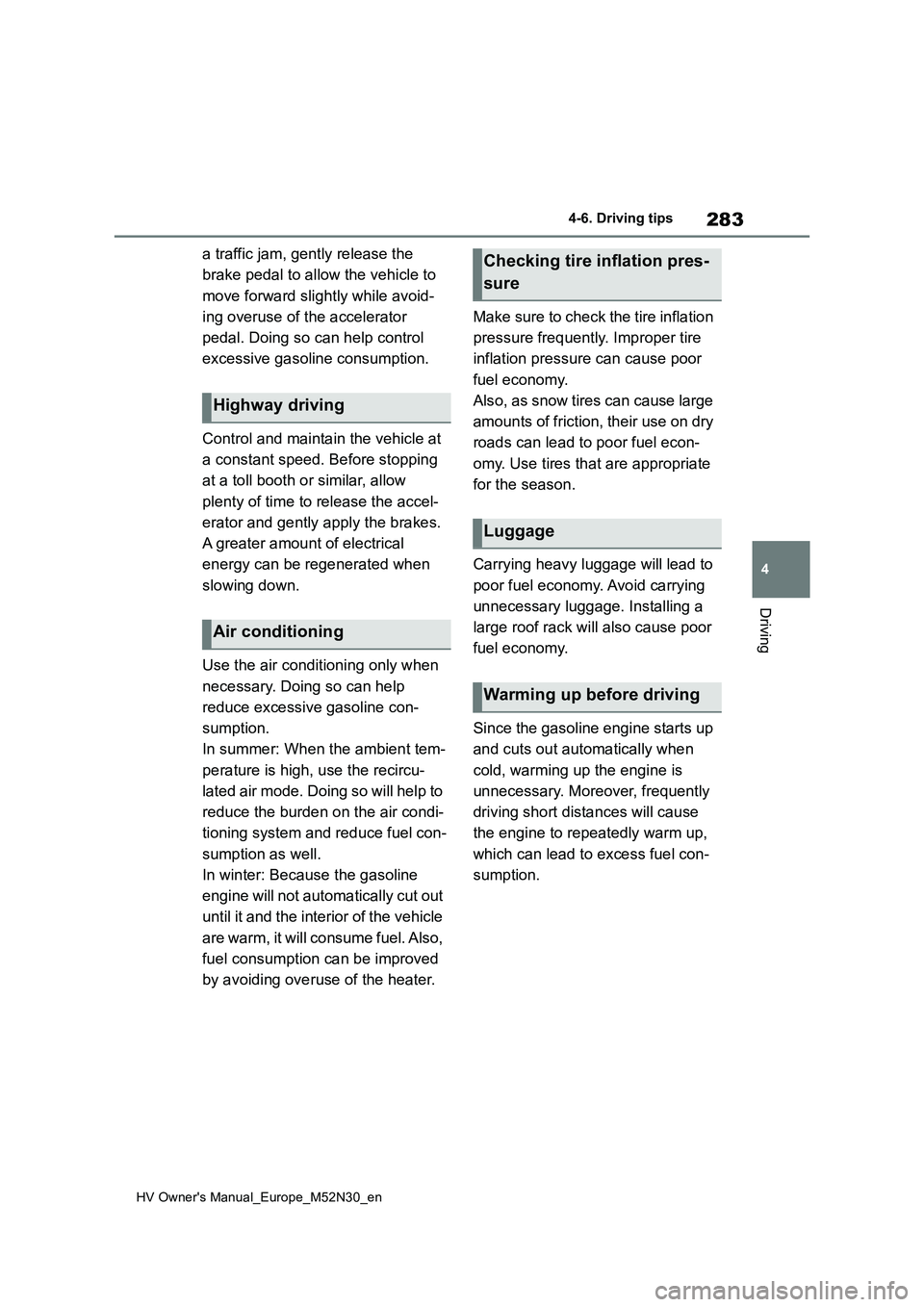
283
4
HV Owner's Manual_Europe_M52N30_en
4-6. Driving tips
Driving
a traffic jam, gently release the
brake pedal to allow the vehicle to
move forward slightly while avoid-
ing overuse of the accelerator
pedal. Doing so can help control
excessive gasoline consumption.
Control and maintain the vehicle at
a constant speed. Before stopping
at a toll booth or similar, allow
plenty of time to release the accel-
erator and gently apply the brakes.
A greater amount of electrical
energy can be regenerated when
slowing down.
Use the air conditioning only when
necessary. Doing so can help
reduce excessive gasoline con-
sumption.
In summer: When the ambient tem-
perature is high, use the recircu-
lated air mode. Doing so will help to
reduce the burden on the air condi-
tioning system and reduce fuel con-
sumption as well.
In winter: Because the gasoline
engine will not automatically cut out
until it and the interior of the vehicle
are warm, it will consume fuel. Also,
fuel consumption can be improved
by avoiding overuse of the heater.
Make sure to check the tire inflation
pressure frequently. Improper tire
inflation pressure can cause poor
fuel economy.
Also, as snow tires can cause large
amounts of friction, their use on dry
roads can lead to poor fuel econ-
omy. Use tires that are appropriate
for the season.
Carrying heavy luggage will lead to
poor fuel economy. Avoid carrying
unnecessary luggage. Installing a
large roof rack will also cause poor
fuel economy.
Since the gasoline engine starts up
and cuts out automatically when
cold, warming up the engine is
unnecessary. Moreover, frequently
driving short distances will cause
the engine to repeatedly warm up,
which can lead to excess fuel con-
sumption.
Highway driving
Air conditioning
Checking tire inflation pres-
sure
Luggage
Warming up before driving
Page 313 of 590
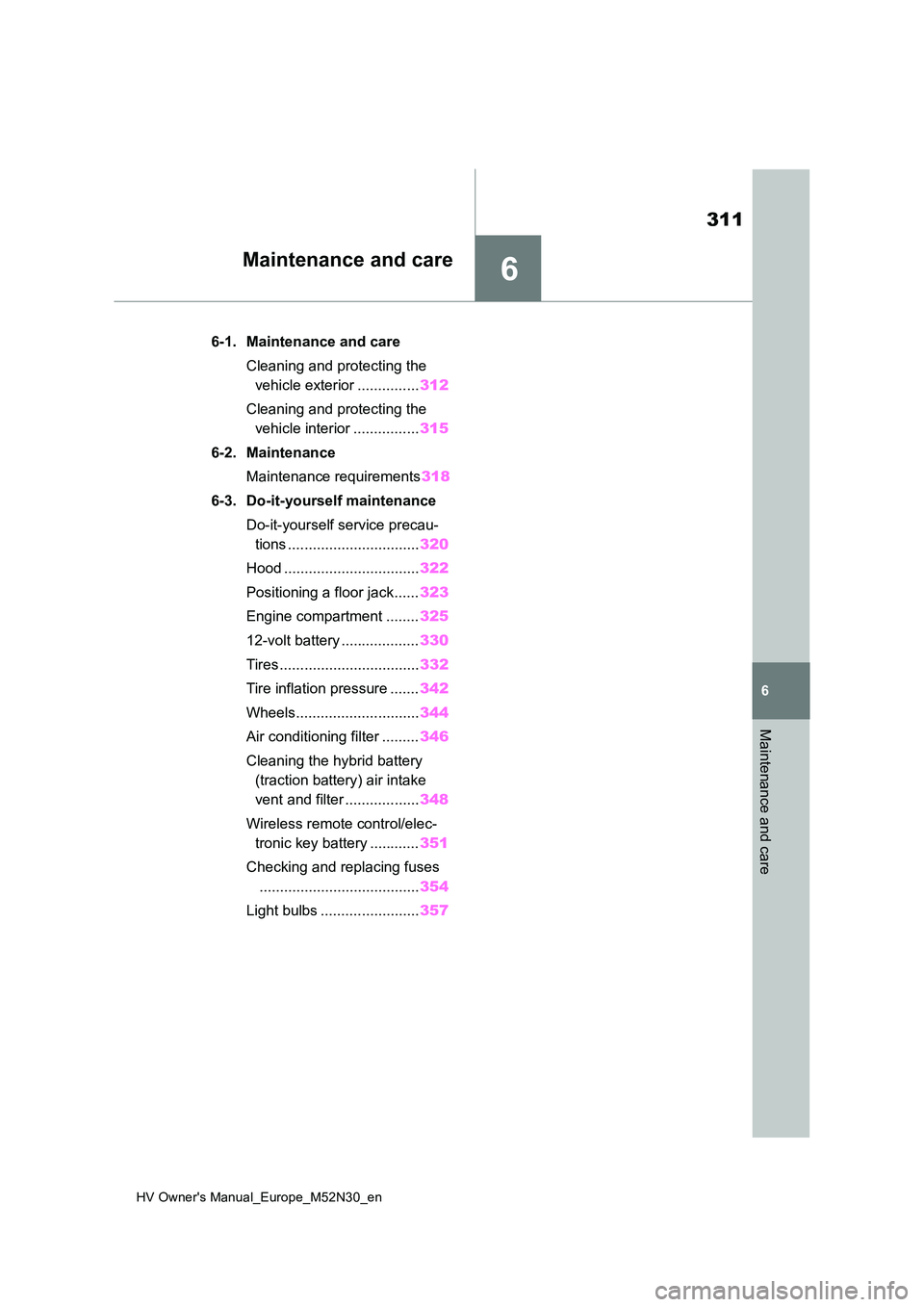
6
311
HV Owner's Manual_Europe_M52N30_en
6
Maintenance and care
Maintenance and care
6-1. Maintenance and care
Cleaning and protecting the
vehicle exterior ............... 312
Cleaning and protecting the
vehicle interior ................ 315
6-2. Maintenance
Maintenance requirements 318
6-3. Do-it-yourself maintenance
Do-it-yourself service precau-
tions ................................ 320
Hood ................................. 322
Positioning a floor jack...... 323
Engine compartment ........ 325
12-volt battery ................... 330
Tires .................................. 332
Tire inflation pressure ....... 342
Wheels.............................. 344
Air conditioning filter ......... 346
Cleaning the hybrid battery
(traction battery) air intake
vent and filter .................. 348
Wireless remote control/elec-
tronic key battery ............ 351
Checking and replacing fuses
....................................... 354
Light bulbs ........................ 357
Page 359 of 590
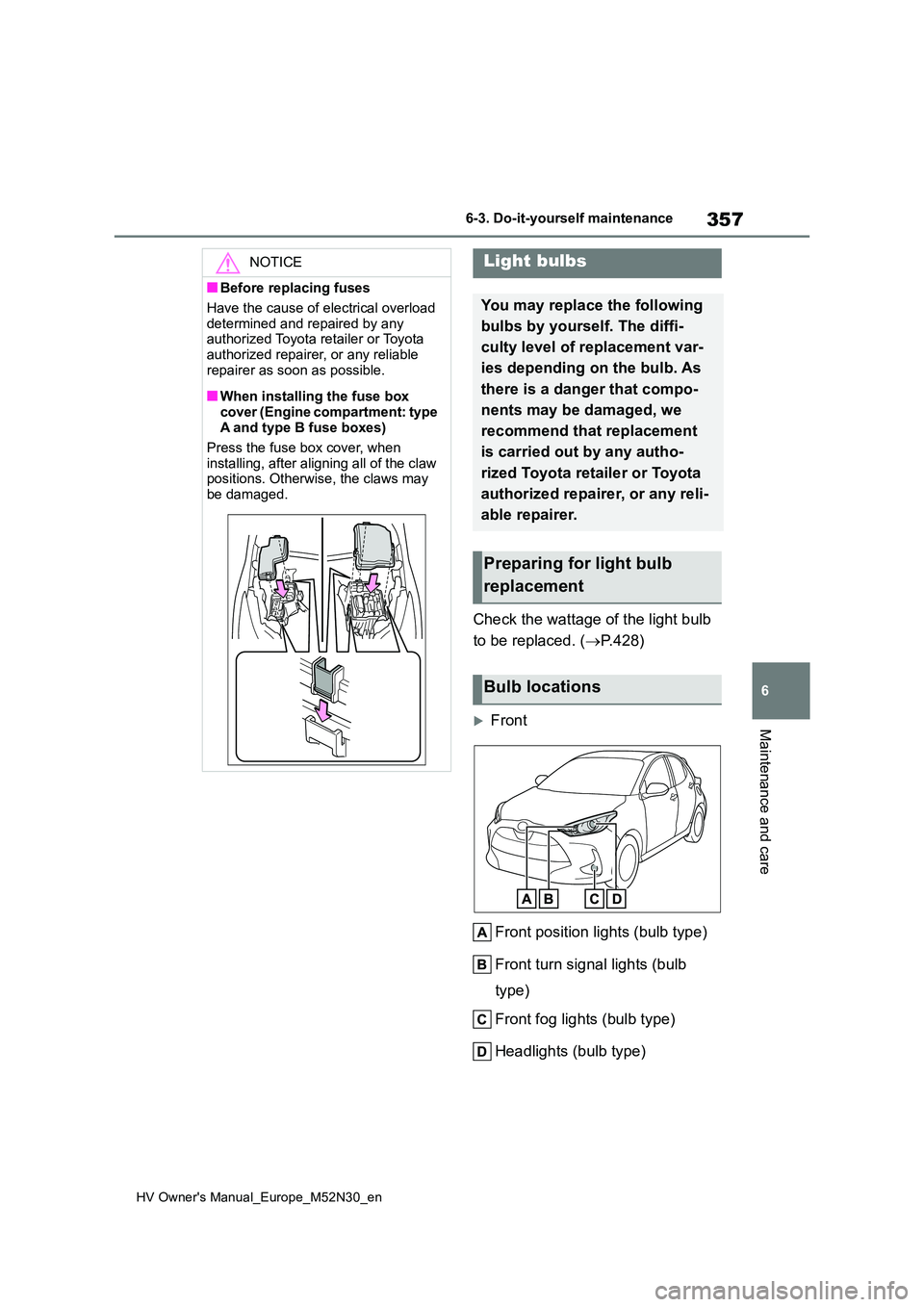
357
6
HV Owner's Manual_Europe_M52N30_en
6-3. Do-it-yourself maintenance
Maintenance and care
Check the wattage of the light bulb
to be replaced. ( P.428)
Front
Front position lights (bulb type)
Front turn signal lights (bulb
type)
Front fog lights (bulb type)
Headlights (bulb type)
NOTICE
■Before replacing fuses
Have the cause of electrical overload
determined and repaired by any authorized Toyota retailer or Toyota authorized repairer, or any reliable
repairer as soon as possible.
■When installing the fuse box
cover (Engine compartment: type A and type B fuse boxes)
Press the fuse box cover, when
installing, after aligning all of the claw positions. Otherwise, the claws may be damaged.
Light bulbs
You may replace the following
bulbs by yourself. The diffi-
culty level of replacement var-
ies depending on the bulb. As
there is a danger that compo-
nents may be damaged, we
recommend that replacement
is carried out by any autho-
rized Toyota retailer or Toyota
authorized repairer, or any reli-
able repairer.
Preparing for light bulb
replacement
Bulb locations
Page 385 of 590
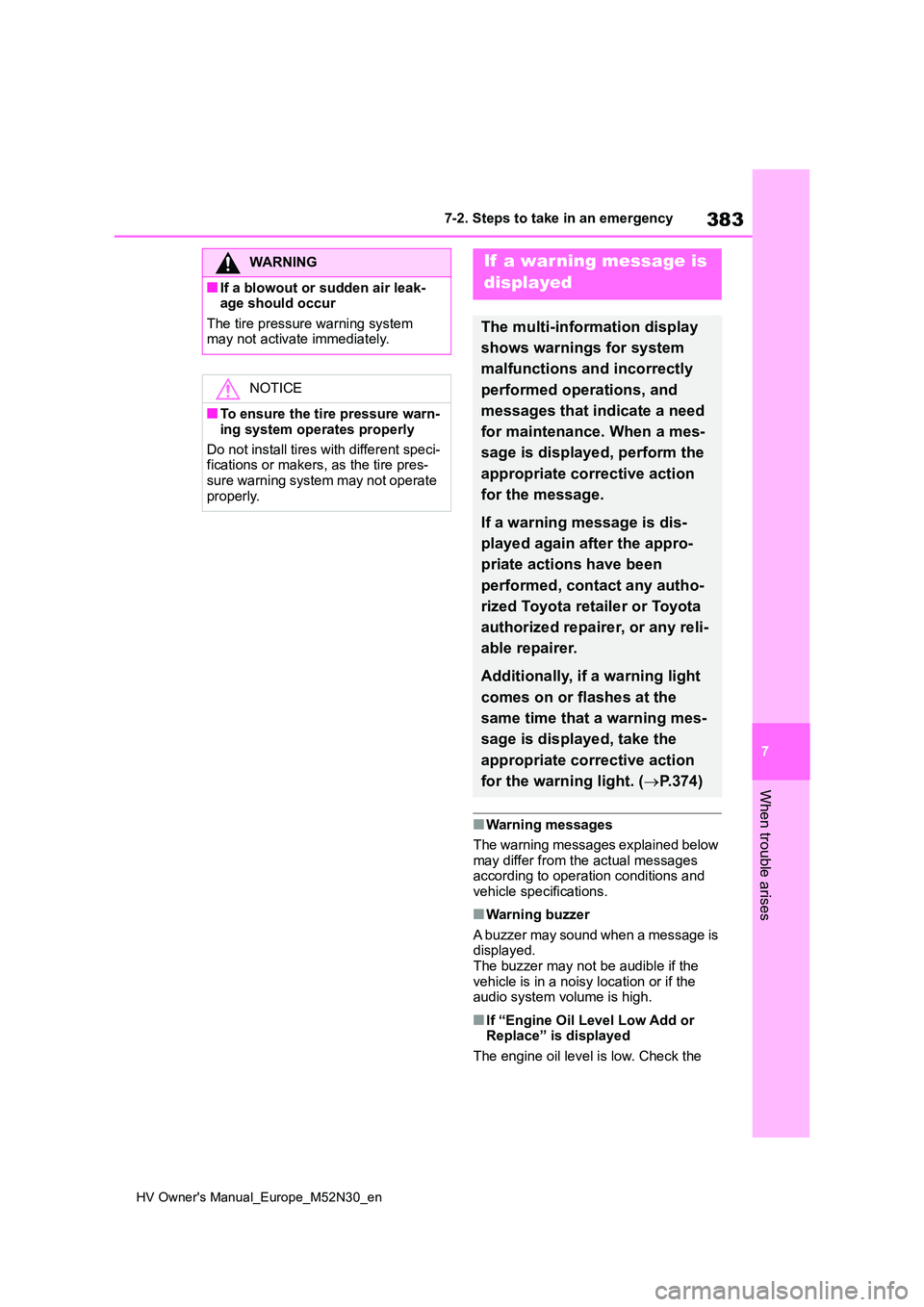
383
7
HV Owner's Manual_Europe_M52N30_en
7-2. Steps to take in an emergency
When trouble arises
■Warning messages
The warning messages explained below
may differ from the actual messages according to operation conditions and vehicle specifications.
■Warning buzzer
A buzzer may sound when a message is displayed. The buzzer may not be audible if the
vehicle is in a noisy location or if the audio system volume is high.
■If “Engine Oil Level Low Add or Replace” is displayed
The engine oil level is low. Check the
WARNING
■If a blowout or sudden air leak- age should occur
The tire pressure warning system may not activate immediately.
NOTICE
■To ensure the tire pressure warn-
ing system operates properly
Do not install tires with different speci- fications or makers, as the tire pres-
sure warning system may not operate properly.
If a warning message is
displayed
The multi-information display
shows warnings for system
malfunctions and incorrectly
performed operations, and
messages that indicate a need
for maintenance. When a mes-
sage is displayed, perform the
appropriate corrective action
for the message.
If a warning message is dis-
played again after the appro-
priate actions have been
performed, contact any autho-
rized Toyota retailer or Toyota
authorized repairer, or any reli-
able repairer.
Additionally, if a warning light
comes on or flashes at the
same time that a warning mes-
sage is displayed, take the
appropriate corrective action
for the warning light. ( P.374)
Page 386 of 590

384
HV Owner's Manual_Europe_M52N30_en
7-2. Steps to take in an emergency
level of the engine oil, and add if neces-
sary.
This message may appear if the vehicle is stopped on a slope. Move the vehicle
to a level surface and check to see if the message disappears.
■If “Hybrid System Stopped Steering Power Low” is displayed
This message is displayed if the hybrid system is stopped while driving.
When steering wheel operations are
heavier than usual, grip the steering wheel firmly and operate it using more force than usual.
■If “Hybrid System Overheated Out-
put Power Reduced” is displayed
This message may be displayed when driving under severe operating condi-
tions. (For example, when driving up a long steep hill.) Handling method: P. 4 1 4
■If “Traction Battery Needs to be
Protected Refrain from the Use of N Position” is displayed
This message may be displayed when
the shift lever is in N.
As the hybrid battery (traction battery) cannot be charged when the shift lever
is in N, shift the shift lever to P when the vehicle is stopped.
■If “Traction Battery Needs to be Protected Shift into P to Restart” is
displayed
This message is displayed when the hybrid battery (traction battery) charge
has become extremely low because the shift lever has been left in N for a certain amount of time.
When operating the vehicle, shift to P and restart the hybrid system.
■If “Shift to P Before Exiting Vehicle” is shown
Message is displayed when the driver’s door is opened without turning the power switch to OFF with the shift lever
in any position other than P. Shift the shift lever to P.
■If “Shift is in N Release Accelerator
Before Shifting” is displayed
The accelerator pedal has been depressed when the shift lever is in N.
Release the accelerator pedal and shift the shift lever to D or R.
■If “Press Brake when Vehicle is Stopped Hybrid System may Over-
heat” is displayed
The message may be displayed when the accelerator pedal is depressed to
hold the vehicle while the vehicle is stopped on an incline, etc. The hybrid system may overheat. Release the
accelerator pedal and depress the brake pedal.
■If “Auto Power OFF to Conserve Battery” is displayed
Power was cut off due to the automatic power off function. Next time when start-ing the hybrid system, operate the
hybrid system for approximately 5 min- utes to recharge the 12-volt battery.
■If “Headlight System Malfunction Visit Your Dealer” is displayed
The following systems may be malfunc- tioning. Have the vehicle inspected by any authorized Toyota retailer or Toyota
authorized repairer, or any reliable repairer immediately.
●The LED headlight system (if equipped)
●Automatic High Beam (if equipped)
■If a message that indicates the mal-function of front camera is dis-played
The following systems may be sus- pended until the problem shown in the message is resolved. ( P.207, 374)
●PCS (Pre-Collision system) (if equipped)
●LTA (Lane Tracing Assist) (if equipped)
●Automatic High Beam (if equipped)
●RSA (Road Sign Assist) (if equipped)
●Dynamic radar cruise control with full-